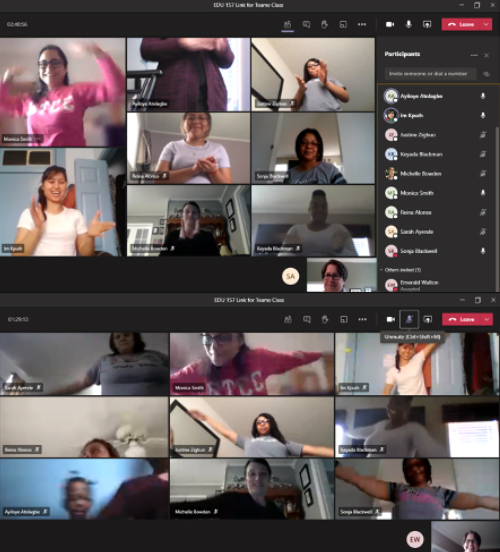GTCC Instructor Keeps Students Moving In Virtual Setting
Published on: February 24, 2021

Shannon Burghart has always believed in lots of physical activity in her classes at Guilford Technical Community College. The associate professor of early childhood education understands that physical movements stimulate the brain.
“We know that all people, children and adults, need brain breaks,” Burghart explains. “We know that brain scans show that our brains are much more ‘lit up’ after physical activity.”
She also is a strong proponent of small classroom groups; that the smaller groups are more productive in educational settings.
Which means, like all instructors, the veteran of more than 9 years of teaching at GTCC was faced with some serious challenges when the college was forced by the COVID-19 pandemic to move to all virtual instruction a year ago.
Burghart was certainly up for the challenge according to her students.
“I did not anticipate this class becoming virtual for the first half of the semester and I must admit I had my doubts that it could work,” Michelle Bowden said, referring to the EDU 157 Active Play class Burghart teaches. “I have been pleasantly surprised at how much I have enjoyed the virtual part of the class and how we still get up and move around, interact and have fun despite it being done virtually.
“Mrs. Burghart really encourages us to engage and physically interact with each other, even during virtual learning, and I have developed a better understanding for just how important active play is for children, especially now.”
To help keep her students active during the three-hour long classes, Burghart schedules what she calls a “brain break” each class,
“I assign two students each class to share a brain break with us. It’s typically a short song and dance in which we all get up and do a little movement where we get to laugh a little and get our blood flowing,” Burghart said. “Allowing the students to lead gives them a little control of the class, allows everyone to see something besides me and shows them new ideas for brain breaks that they can use with children whether they are in person or virtual.”
Burghart has always believed smaller classes were the most productive, but that can be difficult to accomplish in the virtual world. But she figured a way. The veteran instructor uses virtual breakout rooms in Teams meetings with her students to help maintain small group learning. It allows students to work in small groups then come back together to report on their findings.
Burghart has also worked to keep some “low-tech” instruction intact during virtual classes with a measure of fun included.
“When we’re reviewing concepts, I do quiz type questions, but rather than having them answer with Kahoots or other google forms and such, I have them hold up papers with answers on them for a different type of engagement,” Burghart said. “For my Active Play class, for answer A they dance; for B, they run in place; for C, they hop; and for D, they swim.
“I try different methods each week to ensure that we are staying engaged with each other and that they want to keep their cameras on and participate. Anything to see their faces and know that they're engaging with me, each other, and the material!”
Back to All Articles